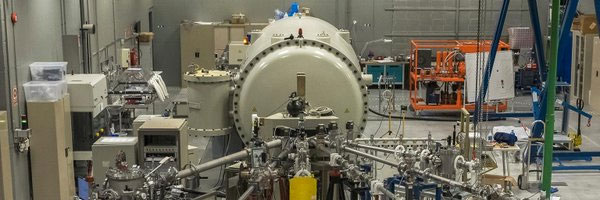Particle accelerators
A particle accelerator is a device that uses electromagnetic fields to accelerate charged particles to high speeds, and thus make them collide with other particles or with a target medium. There are two basic types of particle accelerators: linear and circular. The cathode ray tube of an old television would be something very similar to a particle accelerator.
There are more than 24,000 particle accelerators around the world, mainly dedicated to industrial processes and medical applications, but also to scientific research. This figure includes unique and extraordinary large machines such as the Large Hadron Collider at CERN (reaching TeV energies), and also numerous small machines such as portable X-ray equipment (with low keV energies). Medium particle accelerator installations, which normally generate MeV particles, are in an intermediate regime. They are not as widespread as compact or commercial systems, but neither are they as rare as large synchrotrons or colliders. In fact, according to the IAEA database, there are 163 of these facilities that contain electrostatic accelerators (distributed in 50 countries). These facilities play an important role in the research activities of many disciplines, because they provide the ability to use them for hundreds of scientists.
One of the most widespread uses of these accelerator installations is the modification and analysis of materials using ion beams. On the one hand, ions can be implanted as foreign atoms in the sample for doping, controlling both depth and flow, which is one of the most demanded applications, especially for research in semiconductor materials and microelectronics.
Additionally, MeV ions can be used to induce radiation, sputtering, or mixing damage. Taking advantage of this, other important processes such as nanofabrication, modeling, phase transformation, radiation enhanced diffusion, cutting and amorphization can be achieved. This set of applications is commonly known as ion beam material modification (IBMM).
On the other hand, ion beam techniques can provide valuable information on the structure, nature and composition of materials, allowing for non-destructive depth profiling in many cases. Among this well-established set of powerful techniques, Rutherford backscatter spectrometry (RBS), elastic recoil detection analysis (ERDA), particle-induced X-ray emission (PIXE), and nuclear reaction analysis (NRA, with the particular case of particle-induced gamma) are probably the most popular. However, these techniques are complemented by other more specific methods such as ion channeling (typically combined with RBS), ionoluminescence (IL), ion beam induced current (IBIC) or scanning transmission ion microscopy ( STIM).
These methods are known as ion beam analysis (IBA) techniques. Surprisingly, several of these techniques can be applied simultaneously to extract complementary information in an approach called total-IBA. Recent reports have demonstrated the power of total AIB experiments, which can reduce budget uncertainty by up to 2% in some cases. As a result of these capabilities, which ensure accurate characterization of the elemental composition of samples with good resolution and mass selectivity, the scientists who benefit from them come from multiple disciplines: materials science, biology, geology, environmental science, forensics. , archeology and cultural heritage, astrophysics, radiological protection, etc. In order to make ion beam techniques more accessible to the Iberian scientific community, as well as to the European one, the Center for Materials Microanalysis (CMAM) began to function in 2002 at the Autonomous University of Madrid. Initially it was equipped with a 5 MV tandem accelerator and a MeV ion beam line of any stable element. However, the ion beam laboratory has undergone several improvements and developments since then, regarding ion sources, accelerator, beam lines, and experiment stations. As a consequence, the collection of available techniques and experiments has grown considerably. Furthermore, the availability of energies higher than those achievable in similar facilities has prompted studies of nuclear reactions of astrophysical interest, as well as proof-of-principle studies of proton imaging for PT facilities.
In the last decade, CMAM has supplied around 12,000 hours of beam time, allocating more than 3,000 scientific proposals for internal and external users. Among these non-standard experiments, we highlight the capabilities of CMAM to provide high-energy heavy ions and high-resolution microbeams.
The article presents the current state of the ion beam installation in CMAM, describing the main experimental systems open to users. Particular attention is paid to the more unique features in terms of technical and scientific resources, such as the use of heavy ion beams and internal / external microbeams. Finally, some of the expected developments and scientific perspectives are also mentioned.







